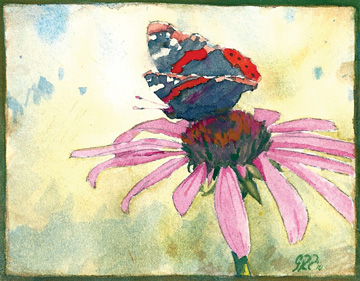Chesapeake Bay's Independent Newspaper ~ Since 1993
1629 Forest Drive, Annapolis, MD 21403 ~ 410-626-9888
Volume xviii, Issue 30 ~ July 29 - August 4, 2010
Home \\ Correspondence \\ from the Editor \\ Submit a Letter \\ Classifieds \\ Contact Us
Best of the Bay \\ Dining Guide \\ Home & Garden Guide \\ Archives \\ Distribution \\ Advertising![]()


Notes from the July GardenJuly 2, North Beach: Red admiral butterflies are abundant in the yard. Some species of butterfly hatch multiple broods during a season. Red admirals have two or more broods in our region. One brood must have just hatched because so many are around. They are one of the widest-spread species on the planet. There is also plenty of Calvert County’s official insect, the zebra swallowtail, flying about. The weather is surprisingly cool, a nice break from the recent heat. But it is going to get hot again. July 4, Jug Bay: Early in the morning, wood thrush, red-eyed vireo, common yellowthroat and summer tanager singing from the woods and marshes. A pair of bald eagles and their fledgling are flying back and forth, as are the osprey, great blue herons and the occasional cormorant. The temperature is rising but humidity is low. July 7, North Beach: The heat wave reached its climax today. The thermometer mounted on the north side of the house reached 100, meaning the air temp might have been 102. I replaced the nectar in the hummingbird feeder so that it doesn’t get moldy. I use plain sugar water, no colorings or additives. I add a half-cup of sugar to 11⁄2 cups of just-boiled water and stir.
July 8, Northern Neck of Virginia: It is still hot. So hot it seems to have caused the songbirds to go quiet. But the Acadian flycatcher and the yellow-billed cuckoo can still be heard in the woods. July 10, North Beach: We are on the verge of a serious drought. It’s been very dry, and June and July 2010 are on pace to go down as two of the hottest months on record. Even some trees and shrubs are showing stress. It has been so dry that it seems to be keeping down the number of the Asian tiger mosquitoes. But we need rain. The forecast says we might get some today. July 13, North Beach: A tomato plant was lost to disease today. It was one of the Black Krims I grew from seed. I hated to pull it up, but we still have one plant of the same variety. Tomatoes are highly susceptible to disease. Late blight is common, but this looks like something else, maybe bacterial canker. If so, I could lose all my plants. Some of the others look as if they are infected, but they are still producing. July 14, North Beach: Strong thunderstorms last night left an inch of badly needed rain. That rain came just in time. July 16, North Beach: Another .15 inches of rain fell last night. We need more, but every bit helps. I picked the first handfull of Kentucky wonder green beans today. I must remember that to harvest beans by July 4, I need to plant a crop by the second week of May. We like to eat steamed fresh green beans with soy sauce, olive oil, garlic and lemon basil. We will eat pounds of them before frost kills the plants. Kentucky Wonder is a good, reliable producer, disease resistant with great taste. Checked the zucchini plant. As far as I can tell there are no signs of the deadly squash vine borer. Good thing since we have only this one plant. We have two cucumber plants; one that I started early has produced well. The young one is growing well but has yet to produce a pickable cuke. I should have started that second plant sooner. The remaining tomato plants are surviving despite signs of disease. I harvested the first of the Black Krim tomatoes for dinner tonight. The heat is making the tomatoes ripen early. Put in four new basil seedlings today. It is time to start thinking about spinach and lettuce for the fall garden. |
© COPYRIGHT 2010 by New Bay Enterprises, Inc. All rights reserved.

 Red admiral on coneflower
Red admiral on coneflower